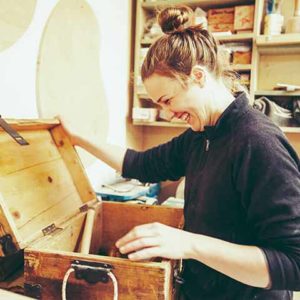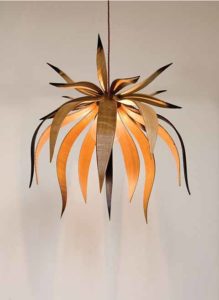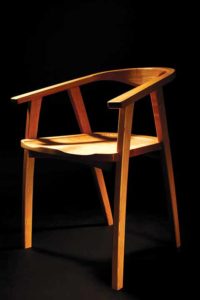Dorset Craft – Wood in the blood
Olivia Lee visits furniture maker and woodworker Alice Blogg
Published in December ’17
On a hill above the village of Nettlecombe sits a beautiful wooden barn, once a farm outbuilding, then a metal forge. When Dorset furniture maker Alice Blogg took it on four years ago, it was dilapidated and empty. Broken glass hung in the windows and hay bales littered the ground. Gradually she fixed it up, scrubbing the floors, painting the walls, weeding the nettles. She designed workbenches from nearby beech trees and built chairs from neighbouring oak. In a way, her barn is a representation of all that she stands for as a furniture maker: local, artisanal, sustainable.


from fitted kitchens, to furniture, to bowls to spatulas, the sheer breadth of products that Alice produces is breathtaking
For Alice, it’s about having a place she can call her own: ‘Sometimes I can’t believe that this is my workshop. I look up at the green fields around Eggardon Hill Fort and suddenly it doesn’t matter that I have an order for 6pm,’ she says. ‘You can’t be stressed when you work somewhere like this.’
Alice Blogg has been a furniture maker for seven years now. She’s only 31, but already has a reputation for creating intricate woodwork from the trees that grow around her. Her commissions include pieces for the Stable restaurant chain and Michelin-starred Gidleigh Park in Devon, as well as bespoke furniture for local and national clients. She’s exhibited at the V&A Gallery and created a trophy that was presented to HM The Queen for her Jubilee. ‘I love that you can do so much with something that’s right on the doorstep,’ says Alice. ‘Imagining these designs and then building them myself, for clients who might keep them for generations – that’s all I want to do.’ Meeting Alice now – listening to her talk in detail about the drying processes of oak compared to ash, or joke about how she’s read every book ever written on wood (‘I’m such a wood geek’) – it’s hard to imagine that she’s done anything but build artisanal furniture on a hilltop above Nettlecombe. But Alice only fell into her job by chance: ‘At 22 I had no idea what I wanted to do,’ says Alice. ‘My mum had always encouraged us (my brothers and me) to be creative, but she was also very sensible. She made us go to university, and wanted us to try and get ‘real’ jobs. While I was working in Tower Bridge, I just kept thinking “is this really what
life’s about?”.’
That was when Alice met Elena, a furniture gilder who’d started her own business when she was 28 and who, decades later, still loved what she did. Alice began helping out at her workshop – not for money, just because she enjoyed being there. ‘It’s funny looking back now, me hanging out with this 50-something,’ Alice says. ‘But I found her so inspiring. I actually wrote her a card years later saying, “Thank you for everything, I’m 28 now and I have my own business too”. She told me she keeps the letter in her cutlery drawer.’
Meeting Elena exposed Alice to a creative industry that she hadn’t known about. ‘It wasn’t as accessible back then,’ says Alice. ‘There wasn’t Instagram, or any of the apps and websites we have now. A lot of my friends were working in offices like me, and they all seemed so happy.’ But Alice wasn’t content. She wanted freedom and fresh air, and a job that inspired her. So she packed up her things and moved home to Dorset.
She got a job sweeping floors at Baker Joinery in Dorchester. ‘I walked past it one day and fell in love with the smell,’ says Alice. ‘I knew right away I wanted to work there, even if it was just doing the odd job.’
Over the next two and a half years, the joiners taught her the fundamentals of woodwork, from traditional joining techniques to the way wood moves and feels alive. It was there that she got her first real commission, to make a desk for someone who had wandered in off the street.
By day she worked as a joiner, by night Alice designed and built furniture, polishing it in her kitchen. As her reputation spread, commissions started coming in. ‘It was exhausting,’ says Alice. ‘Some nights I’d get two hours’ sleep. But I’d finally found something I enjoyed and I needed to make it a success. When you want something that badly, you have to fight for it.’
Alice wanted to be completely self-sufficient, so she did as much as she could on her own. Instead of borrowing money to buy machines, everything was entirely handmade, from cutting to sanding to polishing. ‘I really appreciate how quick my machines are now,’ she says. It was around this time that Alice started poking through her father’s shed, looking for any old equipment he might no longer be using. ‘He had everything!’ she says. ‘He was a building surveyor, and yet he had all these amazing tools.’ She asked him about it. ‘He told me that he had trained as a joiner like me, and used to be a carpenter in his twenties. I didn’t spend much time with him as I was growing up, so I guess I’d never talked to him about his early life. It turns out my grandfather was a woodworker too. And my great grandfather.’ Alice says that there is even one of the old boats her grandfather had made, stored in her father’s attic. ‘It was amazing. I’d just wandered into this world completely by chance, and yet my family had been doing it for generations.’
Like her, they had used the land around them, turning local wood into beautiful creations. She was able to inherit tools that had been used by her family for almost 100 years. Each tool had the same marking scratched into it – a combination of horizontal and vertical lines, to show that it belonged to her family. ‘That marking has become my marking now,’ says Alice.
Today, Alice’s business is thriving. ‘I’m trying not to say the word ‘busy’,’ she says. ‘I just listened to a podcast about how, in England, we always like to say we’re busy. In Denmark they don’t work ‘busy’, they work ‘smart’ — getting everything done in the day and finishing on time. That’s how I want to run my business.’ She has a full-time member of staff – Alan Pinch, her ‘master craftsman’ – and has started work on a number of bigger projects. One of these involves making a twelve-seater table for a client out of the wood from their own forest. Another involves designing and building an entire kitchen and bathroom, from the flooring to the lighting and everything in between. ‘For me, the design is key,’ says Alice. ‘Of course, I will always love making furniture. But with interior design I can make the whole room fit, instead of just designing a table to sit in someone else’s space. I can be really creative – getting all the little pieces to complement each other, thinking laterally about the materials. Is it sustainable? Has it been produced locally? Can we source it from Britain?’
Closer to home though, Alice is building a wood stack in her workshop’s front garden, replacing the nettle bush that’s gradually grown back. It’s going to be somewhere she can store and dry her local Dorset wood – an enormous pile, at least as big as her barn is now. ‘There’s something strangely precious about a pile of wood,’ Alice says. ‘It’s so practical and functional. But it’s magical too. It reminds me that even something very simple can be beautiful.’




